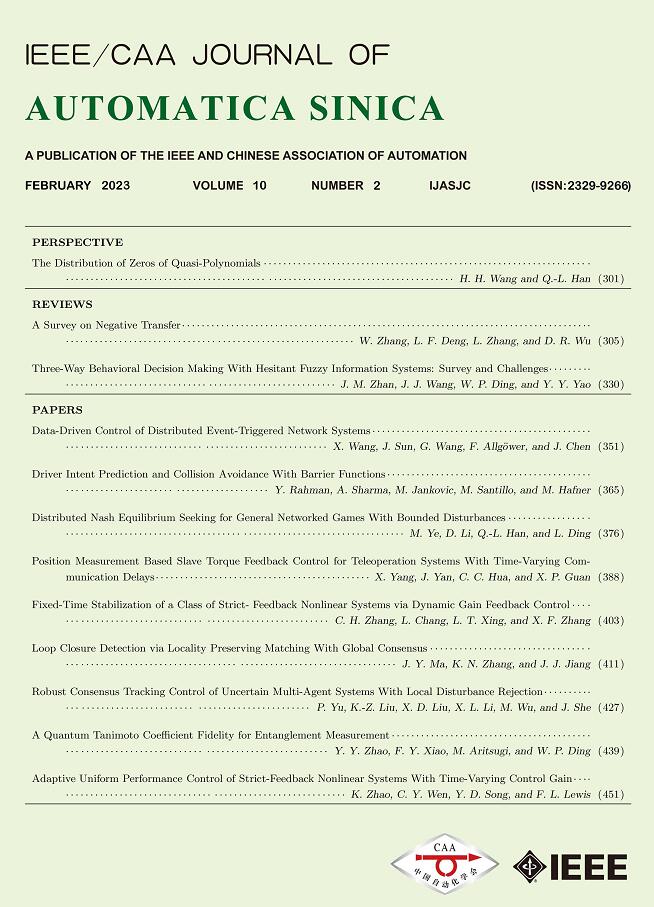 Volume 10
Issue 2
Volume 10
Issue 2
IEEE/CAA Journal of Automatica Sinica
| Citation: | J. Li, Q. Zhou, X. He, and H. M. Xu, “Driver-centric velocity prediction with multidimensional fuzzy granulation,” IEEE/CAA J. Autom. Sinica, vol. 10, no. 2, pp. 547–549, Feb. 2023. doi: 10.1109/JAS.2022.105998 |

| [1] |
J. Huang, Y. Chen, X. Peng, L. Hu, and D. Cao, “Study on the driving style adaptive vehicle longitudinal control strategy,” IEEE/CAA J. Autom. Sinica, vol. 7, no. 4, pp. 1107–1115, Jul. 2020. doi: 10.1109/JAS.2020.1003261
|
| [2] |
J. Li, Y. Gu, C. Wang, M. Liu, Q. Zhou, G. Lu, D. T. Pham, and H. Xu, “Pedestrian-aware supervisory control system interactive optimization of connected hybrid electric vehicles via fuzzy adaptive cost map and bees algorithm,” IEEE Trans. Transportation Electrification, vol. 8, no. 2, pp. 2959–2970, 2021,
|
| [3] |
F. U. Syed, D. Filev, and H. Ying, “Fuzzy rule-based driver advisory system for fuel economy improvement in a hybrid electric vehicle,” in Proc. Annual Conf. North American Fuzzy Information Processing Society, 2007, pp. 178–183.
|
| [4] |
A. Augustynowicz, “Preliminary classification of driving style with objective rank method,” Inter. J. Automotive Technology, vol. 10, pp. 607–610, 2009. doi: 10.1007/s12239-009-0071-8
|
| [5] |
V. Manzoni, A. Corti, P. De Luca, and S. M. Savaresi, “Driving style estimation via inertial measurements,” in Proc. IEEE Conf. Intelligent Transportation Systems, Proceedings, 2010, pp. 777–782.
|
| [6] |
J. S. Neubauer and E. Wood, “Accounting for the variation of driver aggression in the simulation of conventional and advanced vehicles,” SAE Technical Papers, vol. 2, 2013,
|
| [7] |
A. Corti, C. Ongini, M. Tanelli, and S. M. Savaresi, “Quantitative driving style estimation for energy-oriented applications in road vehicles,” in Proc. IEEE Int. Conf. Systems, Man, and Cybernetics, 2013, pp. 3710–3715,
|
| [8] |
Q. Zhou, Y. Zhang, Z. Li, J. Li, H. Xu, and O. Olatunbosun", “Cyber-physical energy-saving control for hybrid aircraft-towing tractor based on online swarm intelligent programming,” IEEE Trans. Industrial Informatics, vol. 14, no. 9, pp. 4149–4158, 2018. doi: 10.1109/TII.2017.2781230
|
| [9] |
J. Li, Q. Zhou, Y. He, H. Williams, H. Xu, and G. Lu, “Distributed cooperative energy management system of connected hybrid electric vehicles with personalized non-stationary inference,” IEEE Trans. Transportation Electrification, 2021.
|
| [10] |
C. Miyajima, Y. Nishiwaki, K. Ozawa, T. Wakita, K. Itou, K. Takeda, and F. Itakura, “Driver modeling based on driving behavior and its evaluation in driver identification,” Proceedings of the IEEE, vol. 95, no. 2, pp. 427–437, 2007.
|
| [11] |
J. Li, Q. Zhou, Y. He, H. Williams, and H. Xu, “Driver-identified supervisory control system of hybrid electric vehicles based on spectrum-guided fuzzy feature extraction,” IEEE Trans. Fuzzy Systems, vol. 28, no. 11, pp. 2691–2701, 2020. doi: 10.1109/TFUZZ.2020.2972843
|
| [12] |
D. P. Filev and I. Kolmanovsky, “Generalized Markov models for real-time modeling of continuous systems,” IEEE Trans. Fuzzy Systems, vol. 22, no. 4, pp. 983–998, 2014.
|
| [13] |
L. Johannesson, M. Åsbogård, and B. Egardt, “Assessing the potential of predictive control for hybrid vehicle powertrains using stochastic dynamic programming,” IEEE Trans. Actions Transportation Systems, vol. 8, no. 1, pp. 71–83, 2007.
|
| [14] |
J. Jing, D. Filev, A. Kurt, E. Özatay, J. Michelini, and Ü. Özgüner, “Vehicle speed prediction using a cooperative method of fuzzy Markov model and auto-regressive model,” in Proc. Intelligent Vehicles Symposium, 2017, pp. 881–886.
|
| [15] |
A. Hirotogu. “Information theory and an extension of the maximum likelihood principle,” in Selected Papers of Hirotugu Akaike, New York, USA: Springer, 1998, pp. 199–213.
|
| [16] |
L. Liu, A. L. Yang, W. J. Zhou, X. F. Zhang, M. R. Fei, and X. W. Tu, “Robust dataset classification approach based on neighbor searching and kernel fuzzy C-means,” IEEE/CAA J. Autom. Sinica, vol. 2, no. 3, pp. 235–247, 2015. doi: 10.1109/JAS.2015.7152657
|
| [17] |
Y. Zhang, “Support vector machine classification algorithm and its application,” in Proc. Int. Conf. Information Computing and Applications, Springer, Berlin, Heidelberg, 2012, pp. 179–186.
|
| [18] |
J. Li, Q. Zhou, Y. He, B. Shuai, Z. Li, H. Williams, and H. Xu, “Dual-loop online intelligent programming for driver-oriented predict energy management of plug-in hybrid electric vehicles,” Applied Energy, vol. 253, p. 113617, Nov. 2019. doi: 10.1016/j.apenergy.2019.113617
|
| [19] |
C. Lin, H. Pengl, and J. W. Grizzle, “A stochastic control strategy for hybrid electric vehicles,” in Proc. American Control Conf., 2004, pp. 4710–4715.
|
| [20] |
T. Liu, X. Hu, S. E. Li, and D. Cao, “Reinforcement learning optimized look-ahead energy management of a parallel hybrid electric vehicle,” IEEE/ASME TRANS. Mechatronics, vol. 22, no. 4, pp. 1497–1507, 2017.
|